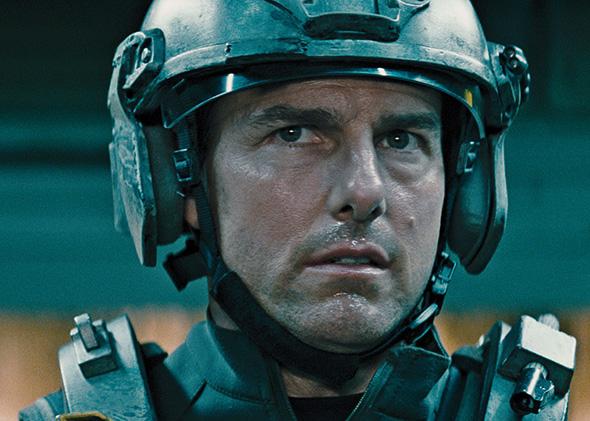As you may have heard, the new Tom Cruise movie is basically an alien-invasion Groundhog Day, in which our hero must live the same day over and over again, trying to do it a little better each time. But whereas the Harold Ramis–Bill Murray classic is a comic meditation on getting over yourself and learning to appreciate life, Edge of Tomorrow is about something else: making action movies.
It begins with the sort of montage you’ve seen in a million other Hollywood blow-’em-ups, particularly post-9/11: a series of clips from faux-news broadcasts, which quickly convey that in this version of the near-future a mysterious alien race that looks like the demon spawn of the Flying Spaghetti Monster has invaded the Earth and rapidly annihilated much of it. Europe, in particular, is a bloody mess. In a few of these clips, we see a military spokesman named William Cage (Cruise), who looks like the slick propagandist that he is. You may recognize him from the many other films in which Tom Cruise has played a callow hustler of one kind or another, from The Color of Money to Rain Man to Jerry Maguire. The most obvious precedent is Lt. Daniel Kaffee, the Navy lawyer from A Few Good Men, who, like Cage, begins his movie hoping to avoid real work or risky entanglements.
Cage’s Colonel Jessup is Gen. Brigham (Brendan Gleeson), British leader of the United Defense Force, the international military effort to thwart the extraterrestrials. He orders Cage to the front with a camera crew, the better to sell his impending, D-Day–like invasion of alien-dominated France to a worldwide audience of potential recruits. When Cage refuses and then runs—Tom Cruise does like to run—Brigham has him handcuffed and shipped to the front with new orders: to join the squad of grunts who will storm the beach first and surely be slaughtered. He shortly is.
And then he wakes up: back at the base, in handcuffs, experiencing the previous day all over again, Phil Connors–like. How or why this is happening is not clear at first, but on one of his repeat trips to the invasion, Cage finds the Virgil who can guide him through this hell: Rita Vrataski, a legendary UDF soldier called the Angel of Verdun because of her miraculous feats of alien-killing in that old French city best known for a brutal WWI battle. Rita—the name, as Manohla Dargis points out, may be a nod to Andie MacDowell’s character in Groundhog Day—is played by Emily Blunt, whose surprising performance as an utterly convincing badass may be the best thing about this movie. Vrataski, too, had a period of chronic do-overs and, unlike Cage, she knows why: It has to do with those murderous extraterrestrials, called (for reasons that were never quite clear to me) Mimics. They can control time, and because Cage killed one of the “Alpha” Mimics, that time control was passed on to him. He now has the power to “reset the day.”
Perhaps the speculative biology and metaphysics of all this is clearer in All You Need Is Kill, the illustrated Japanese novel by Hiroshi Sakurazaka that Edge of Tomorrow is based on. In the movie, though, it’s just graspable enough for you to focus on what really matters: watching Tom Cruise get killed over and over and over again. Vrataski takes Cage under her wing—or, rather, under her giant, weaponized cricket bat—and schools him in the art of near-future warfare. Then they attempt to memorize the events of the beach invasion so that they can duck and weave and kill their way to the lead alien beast, a kind of central brain that, as we learn in a looong scene of exposition, directly controls the littler creepy-crawlies causing all the carnage across the continent.
If that sounds like a video game, it should. Sakurazaka’s novel was inspired by playing one, and Edge of Tomorrow is essentially a cinematic version of Halo in which a single player gets unlimited lives so that he can learn to dodge all the enemies and win the game. That repetition would get tedious if not for the comic brio that Cruise and director Doug Liman bring to the butchery: Again and again, Cage tries and fails to dodge some weapon or vehicle or alien tendril and amusingly goes down.
This practice-makes-perfect routine looks a lot like an actor rehearsing his stunts—and as Cruise is fond of reminding us, he does his own stunts. This is surely not a coincidence: Liman and his screenwriters have built in enough nods to other movies—Groundhog Day, Alien, Saving Private Ryan, and so on—to make clear that the meta-ness is the point. This is a movie about Tom Cruise working very, very hard to please the world.
And please me he did, though I was already a fan. Not that the pleasure was particularly profound: Despite the movie’s allusions to World Wars I and II, Edge of Tomorrow is utterly shallow when it comes to war, giving us an inhuman enemy we are never asked to understand and a small cast of fellow soldiers who are mostly forgettable. Lately, it seems, we don’t expect anything more from a Tom Cruise movie: He’s taken on a string of big-budget, crowd-pleasing action flicks, after avoiding them for most of his career. Watching his physically expert but psychologically thin performance in this one, it’s hard not to feel as though he, too, is caught in a time loop of sorts, doing variations on the same thing over and over—and getting very good at it, but with much less than the fate of humanity at stake.
